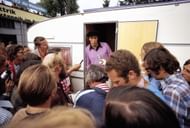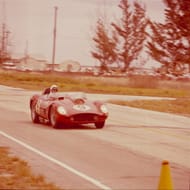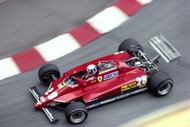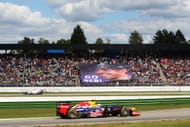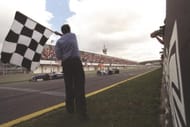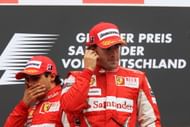Part 1 can be found here.
The Nurburgring has claimed the lives of 68 – yes, 68 drivers – since it was first used as a racetrack in 1927. The average becomes even more alarming when we consider that it was left unused for 12 years due to firstly the Second World War and then Germany’s defeat in it. During the time when the old longer course was used for Formula 1 races, it claimed the lives of 5 drivers in a 15-year span. It could easily have been 6 in its last year of hosting the German Grand Prix:-
Niki Lauda: lucky to be alive
1976 was the last time that the old Nurburgring would host a Formula 1 Grand Prix. Unfortunately, even on the last occasion, the demons of the ill-fated track reared their ugly heads and this time claimed none other than defending champion Niki Lauda. Almost.
The Austrian lost control of his Ferrari on the exit of the left-hand kink before Bergwerk and while the car spun back onto the track after colliding with the barriers, Brett Lunger collided with the Ferrari which had already caught fire. With the track being so long and running through the forests, it was not possible to have marshalls everywhere. So the only help at hand were the drivers themselves and had Lunger, Arturo Merzario and Harald Ertl not jumped out of their cars and drawn the Austrian out of his burning Ferrari, it would have been all over for the Ferrari driver there and then.
The world had given up hope on Lauda when it was reported how badly his body had been burned and his lungs damaged from inhaling the toxic fumes. But it was the sheer determination – one thing which Lauda had in excess – which helped him stun everybody by lining up on the grid just 6 weeks later with blood seeping down his heavily bandaged head.
Drivers won’t race at the Ring
In the aftermath of Piers Courage’s demise at Zandvoort in June, 1970, the drivers, led by Sir Jackie Stewart, announced they wouldn’t race at the Nurburgring that year on safety grounds. With many voices now behind Stewart, the governing body had to budge and the Hockenheimring was promptly prepared for that year’s German Grand Prix.
This was the first time the drivers raised their voices and this crusade for safety would slowly start phasing out the legendary Nordschleife from the F1 calendar.
Final nail in the coffin
Niki Lauda’s horrific accident in 1976 proved to be the final nail in the coffin for the old Nurburgring. Whatever hopes the organizers of the track had of reinstating it in its original form on the calendar were put to bed because of this incident. The only solution was to heavily modify it to match the Formula 1 safety standards.
They did that and 8 years later the track held another F1 race, which was labelled as the European Grand Prix. Next year, their aim was finally fulfilled when the German Grand Prix was back at the Nurburgring.
AVUS: First and last time
1959 was the only year when an F1 world championship race was held at the AVUS track in Berlin. It basically consisted of two long straights joined at the two ends by big radius curves- which were flat initially but bankings were introduced in the 1930′s. Although the track layout looked quite simple and straightforward, it still claimed the life of a driver during its only presence on the calendar.
The reason for that was the infamous 43-degree banking on the Nordkurve which had no wall or fence on its top (outside) to prevent the cars from flying off the track at high speed. That is exactly what happened with ex-Ferrari driver Jean Behra when he was participating in a supporting sportscar race. The track was deemed unfit for racing in later years because Formula 1 racing was stopped on banked circuits very soon after. Dangerous bankings at Monza and Montlhery were removed.
End of the road for Didier Pironi
Ferrari driver Didier Pironi crashed heavily during the wet qualifying of the 1982 German Grand Prix at Hockenheim. Ironically, it was in a similar manner to his arch rival Gilles Villeneuve, who had met his death at Zolder a few months earlier. Unable to see because of the spray from Derek Daly’s car, Pironi collided into the back of Alain Prost and was skyborn for a moment. The Frenchman’s legs were so badly injured that FIA doctor Sid Watkins had given amputating them a thought, just to get him out of the car. Ultimately, he did not lose his legs but he never raced in F1 again.
Spectators can’t experience the action
When the Hockenheim layout with the long straights through the forests was used, most of the overtaking used to take place either by virtue of slipstreaming or by outbraking at the corners at the end of the straights. Unfortunately, neither of those could happen in the stadium section where the grandstands were present.
So to prevent the track from losing the Grand Prix due to negative publicity, Hermann Tilke was assigned with redesigning the track (new layout was run in 2001) and as a result, what we see today is quite similar to other Tilke tracks.
Who will host the German Grand Prix?
It was decided that from 2007 onwards, Nurburgring and Hockenheim would alternately host the German Grand Prix. Hockenheim had been hosting the German Grand Prix for the last 30 years since 1977 (barring 1985) and so they couldn’t agree to sharing the naming rights with Nurburgring. As a result, the race held in Nurburgring was renamed as the European Grand Prix and it was the first time since 1960 that there would be no German GP on the F1 calendar.
Fernando is faster than you
Who would forget this team radio message? Felipe Massa was ordered to let teammate Fernando Alonso through during the 2010 German Grand Prix, so as to enhance Alonso’s championship chances. Ferrari earned a lot of flak for that but ultimately escaped without major penalties and “only” a $100,000 fine.
The German Grand Prix has been one of the long-lasting races on the calendar and the nature of the tracks which have played host to the race have played a huge part in this being one of the most awaited races on the calendar for teams and fans alike. This year we are sure to have more enthusiasm in the build-up to the race as compared to recent years, courtesy the success of Mercedes.
